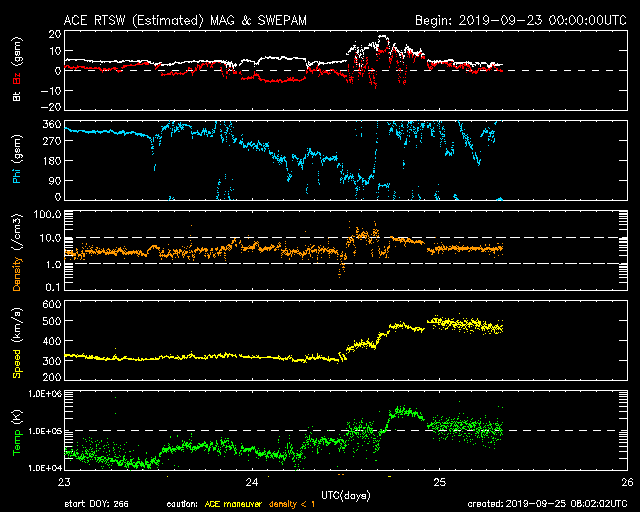Enhanced solar wind environment after glancing blow from a slow-moving CME

Solar wind parameters over the past 24 hours were indicative of enhanced solar wind environment, likely caused by a combination of a glancing blow from a slow-moving Coronal Mass Ejection and influences of a negative polarity CH HSS.
Total IMF strength was at 5 to 6 nT until 12:00 UTC, September 24, when it increased and reached a maximum value of 17 nT by 16:11 UTC, SWPC forecasters said 00:30 UTC on September 25, 2019.
The Bz component varied in conjunction with the strengthened Bt. However, it was orientated predominantly northward through the disturbance.
Solar wind speed was at 300 – 325 km/s until 12:00 UTC then increased, reaching speeds of ~500 km/s by 22:23 UTC.
The phi angle rotated somewhat steadily through 360 degrees from negative to positive and back to negative.
.gif)
"It is unclear as to the precise cause of the disturbed solar wind environment. However, an enhancement was anticipated due to influences of a negative polarity CH HSS and an embedded, weak glancing transient arrival," SWPC said.
The Coronal Mass Ejection (CMS) was produced after a solar filament, centered near S35W02, erupted around 22:00 UTC on September 19 (as observed in SDO/AIA 304 imagery). A narrow, slow-moving CME signature was observed in STEREO-A COR2 imagery after 00:00 UTC, September 20.
A disturbed and enhanced solar wind environment is expected to continue into September 25, with a return to a more ambient, background-like state anticipated by September 26.
A Co-Rotating Interaction Region (CIR) ahead of a recurrent, isolated, positive polarity CH HSS is likely to arrive later on September 27, and is expected to cause an enhancement in the IMF.


Image credit: NASA/SDO, SolarHam
The geomagnetic field was quiet to active in varying response to the disturbed and enhanced solar wind state.
It is expected to respond with quiet to active levels on September 25 in continuing reaction to the disturbed solar wind state.
Weakened solar wind conditions by September 26 are anticipated to result in mainly quiet to unsettled levels.
Most of September 27 is expected to experience quiet to unsettled conditions.
However, active to G1 – Minor storm levels are likely later in the period in response to CIR arrival.
.png)
.png)
Featured image: NOAA/SWPC

The Phi angle should NEVER be Above 180 degrees… Anything above 180 Indicates a backside Connection with another Solar Body!!! >>> “What does Phi mean? (Blue line)
Phi is the angle of the interplanetary magnetic field that is being carried out by the solar wind. Phi is measured in the GSM (geocentric solar magnetospheric) coordinate system. In this system the X-axis points from the Earth to the Sun and the Z-axis is pointing along the direction of the Earth’s north magnetic pole. This puts the Y-axis roughly pointing to the left as one looks at the Sun from the Earth. Phi is the angle made by the field in the XY plane. This means that >. Sudden and rapid changes in the Phi angle in conjunction with increased solar wind speeds and Bz fluctuations is common during a CME impact.” http://www.solarham.net/help/ace.htm